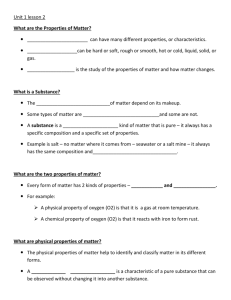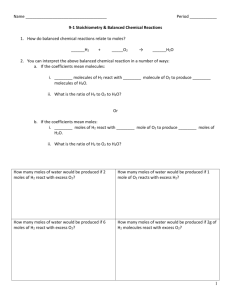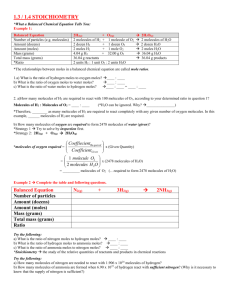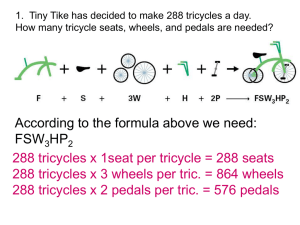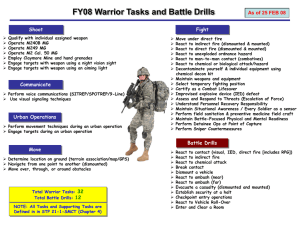Chapter 10
advertisement
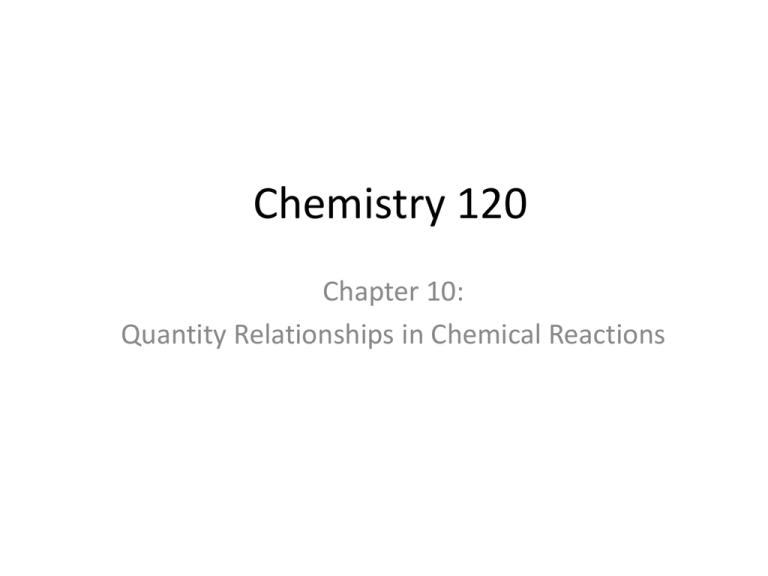
Chemistry 120 Chapter 10: Quantity Relationships in Chemical Reactions Moles & Equation Coefficients 2 NO(g) + O2(g) → 2 NO2(g) NO (g) O2(g) NO2(g) 2 molecules 1 molecule 2 molecules 2000 molecules 1000 molecules 2000 molecules 12.04 × 1023 molecules 2 moles 6.02 × 1023 molecules 1 mole 12.04 × 1023 molecules 2 moles 3 Fig. 10-2, p. 276 Example - Stoichiometry • Iron metal reacts with powdered sulfur, S, in the presence of heat to produce iron(III) sulfide. • How many moles of sulfur react with 1.50 moles of iron? Example - Stoichiometry • How many liters of carbon dioxide are produced when 2.25 L of propane, C3H8, a hydrocarbon, undergo combustion. Example - Stoichiometry • How many grams of oxygen gas must react with excess zinc to produce 1.28 g of zinc oxide? Example - Stoichiometry • Calcium cyanamide, CaCN2, reacts with water to form calcium carbonate and ammonia gas. How many grams of water are needed to react with 75.0 g of calcium cyanamide? Example - Stoichiometry • When ferric oxide is heated with carbon, molten iron and carbon monoxide are produced. • How many kilograms of iron are produced if 1.0 pounds of carbon react with excess ferric oxide? Example – Percent Yield • If 2.50 g of aqueous cadmium chloride reacts with excess aqueous sodium sulfide to produce 0.971 g of cadmium sulfide solid, what is the percent yield of cadmium sulfide? Example – Limiting Reagent • Suppose that 7.50 moles of iron are heated with 2.00 moles of sulfur, how many moles of iron(II) sulfide are produced? Use an ICE table. Example – Limiting Reagent • Ammonia and fluorine gases react to form dinitrogen tetrafluoride and hydrogen fluoride gases. • If 5.00 g of ammonia and 20.0 g of fluorine gas react, how many grams of hydrogen fluoride gas are produced? Use an ICE table. Example – Limiting Reagent • If 12.8 g of sodium react with 10.2 g of chlorine gas and 16.201 g of sodium chloride is produced, what is the percent yield? Use an ICE table. Example – Thermochemical Equations • When octane, C8H18, in gasoline burns in an automobile engine 8.5 x 103 J of heat are released. How many kJ of heat are released if 10.0 g of octane is combusted? Example – Thermochemical Equations • The electrolysis of water is an endothermic reaction, absorbing 286 kJ for each mole of liquid water decomposed into its elements. How many grams of water are decomposed if 5,000 kJ of energy are absorbed? Example – Thermochemical Equations • Solid sulfur reacts with carbon dioxide gas to produce sulfur dioxide gas and carbon solid, ∆H = -75.8 kJ. When 5.20 g of sulfur react with excess carbon dioxide, how many kJ of energy are evolved or absorbed?
